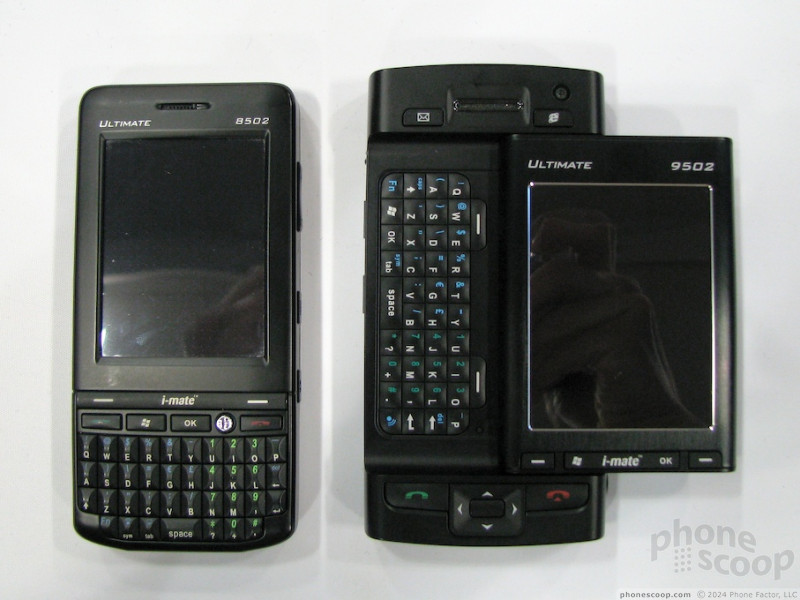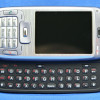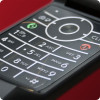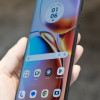CTIA Fall 2007
We were able to spend some time with the new Ultimate series of Windows Mobile smartphones from i-Mate. The 8502 and 9502 share most features, such as the processor, HSDPA data and so on. There are also many differences hiding under the covers as well. All the i-Mates we played with were preproduction. We were told that while the shape and configuration of the buttons and hardware will not change, their feel will likely be improved by the time final models are available for sale.
8502
The 8502 is a standard-looking bar-style smartphone, with screen and full QWERTY keyboard below. It is fairly thick and heavy, and feels more robust than your typical smartphone. Though it is thicker than most bar-style smartphones, it still feels thicker than it actually is because of it's right angle design. It is like holding a brick in your hand. There is more metal in the design, and less plastic, adding to the bulk.
The screen is generous in size, but the phone is top heavy, creating difficulties when typing two-handed. This is exacerbated by the fact that the keyboard is very much squished down at the bottom of the phone. This creates a nasty cramping sensation in your hands after a few moments of typing out messages.
On top of that, the keyboard offered very little feedback. The keys were mushy and it was difficult to discern when you had pressed most of the keyboard buttons. We were told that this would likely be improved by the time production units are ready. But that will not fix how narrow the keys are. They are about half a centimeter (maybe a quarter inch) wide and stacked right next to each other with no space between. It was very hard to type with.
The mushy key syndrome is carried over to the function and menu keys above the QWERTY keyboard, as well. They simply didn't have any feedback, or offer any sort of “click” to let you know that the buttons had been pushed.
There are three ways to navigate with the 8502 (and 9502). You can use a BlackBerry-esque jog dial on the left side of the phone, a tiny little joystick on the front of the phone, or a combination of the stylus and your finger on the screen itself. The jog dial was very tiny, and felt cheap to us.
No matter which way you chose to navigate, there was a lot of lag between performing actions on the phone and having anything actually take place. Everything about using these phones was slow and buggy, which we are hoping is due to the fact that they are preproduction models.
9502
The 9502 offers more in terms of features over the 8502, but the price you pay for that is weight. It is one heavy phone. The word brick comes to mind, especially given its less-than-dainty girth. It is also made of metals, and this likely contributes to the weight.
Many of the control buttons on the 9502 offered similar feedback issues as the 8502. But it adds a number of buttons, including dedicated email and Internet keys, that make jumping directly into some programs or applications a little bit faster.
It has a 3 megapixel camera (compared to the 8502's 2 megapixel camera) and also includes a user-facing VGA camera for video calling capabilities. The biggest different is that it has a slide up keyboard. In fact, the 9502 very much resembles the Motorola Sidekick Slide. It is just a heavier, clunkier version that offers a more enterprise-focused feature set.
Because of the size and shape of the 9502, we expected the keyboard to be much like the one found on Sidekicks. Instead what we found was a small, cramped keyboard. The keys on the 9502 are wider than the 8502, and feel similar to those found on HTC devices, but were also plagued by feedback issues. The keyboard is also crammed into the cavity created by the sliding screen. Because it is buried deep between the ridges of the phone, getting your thumbs in to hit the keys along the outside of the keyboard (i.e., the Q, A, Z, or P, L, M) is a chore and led to thumb cramps.
Neither of these phones is aimed at consumer users. They are hearty enterprise-class smartphones that will likely find an audience with field force personnel who need more rugged equipment.
Lack of refinement aside, they do offer a lot of standard features and should be powerful mobile computing platforms when ready for sale.
We took a short video comparison of both phones. You can watch it here:
Or visit YouTube for more viewing and sharing options.








 Review: LG Rumor
Review: LG Rumor
 Review: HTC SMT-5800
Review: HTC SMT-5800
 Video Review: Samsung BlackJack II
Video Review: Samsung BlackJack II
 CTIA 2007
CTIA 2007
 Hands On with the Motorola edge+ (2023)
Hands On with the Motorola edge+ (2023)
 HTC 5800 / Fusion / S720
HTC 5800 / Fusion / S720
 UTStarcom Mini 8935
UTStarcom Mini 8935
 UTStarcom Super Slice / CDM-1450
UTStarcom Super Slice / CDM-1450






